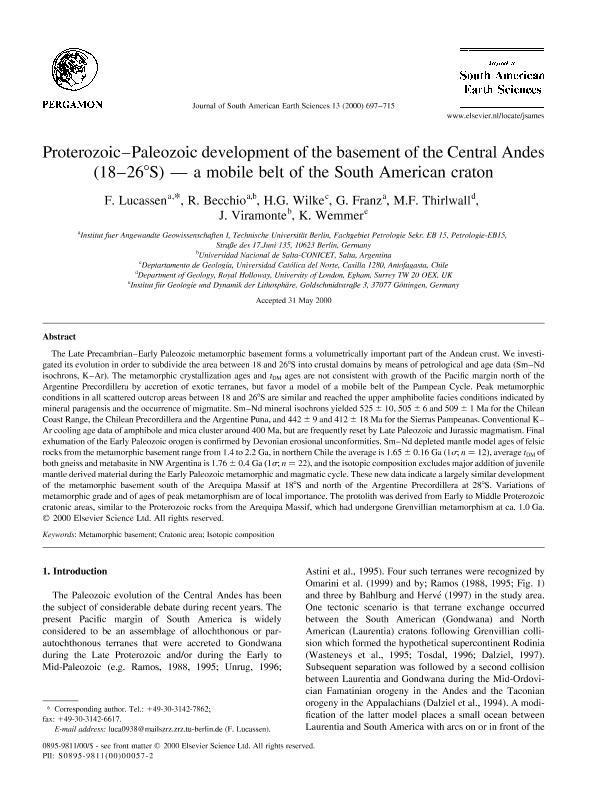Artículo
Proterozoic-Paleozoic development of the basement of the Central Andes (18-26°S) - A mobile belt of the South American craton
Lucassen, F.; Becchio, Raul Alberto ; Wilke, H.G.; Franz, G.; Thirlwall, M.F.; Viramonte, Jose German
; Wilke, H.G.; Franz, G.; Thirlwall, M.F.; Viramonte, Jose German ; Wemmer, K.
; Wemmer, K.
 ; Wilke, H.G.; Franz, G.; Thirlwall, M.F.; Viramonte, Jose German
; Wilke, H.G.; Franz, G.; Thirlwall, M.F.; Viramonte, Jose German ; Wemmer, K.
; Wemmer, K.
Fecha de publicación:
12/2000
Editorial:
Pergamon-Elsevier Science Ltd
Revista:
Journal of South American Earth Sciences
ISSN:
0895-9811
Idioma:
Inglés
Tipo de recurso:
Artículo publicado
Clasificación temática:
Resumen
The Late Precambrian-Early Paleozoic metamorphic basement forms a volumetrically important part of the Andean crust. We investigated its evolution in order to subdivide the area between 18 and 26°S into crustal domains by means of petrological and age data (Sm-Nd isochrons, K-Ar). The metamorphic crystallization ages and tDM ages are not consistent with growth of the Pacific margin north of the Argentine Precordillera by accretion of exotic terranes, but favor a model of a mobile belt of the Pampean Cycle. Peak metamorphic conditions in all scattered outcrop areas between 18 and 26°S are similar and reached the upper amphibolite facies conditions indicated by mineral paragensis and the occurrence of migmatite. Sm-Nd mineral isochrons yielded 525 ± 10,505 ± 6 and 509 ± 1 Ma for the Chilean Coast Range, the Chilean Precordillera and the Argentine Puna, and 442 ± 9 and 412 ± 18 Ma for the Sierras Pampeanas. Conventional K-Ar cooling age data of amphibole and mica cluster around 400 Ma, but are frequently reset by Late Paleozoic and Jurassic magmatism. Final exhumation of the Early Paleozoic orogen is confirmed by Devonian erosional unconformities. Sm-Nd depleted mantle model ages of felsic rocks from the metamorphic basement range from 1.4 to 2.2 Ga, in northern Chile the average is 1.65 ± 0.16 Ga (1σ, n = 12), average tDM of both gneiss and metabasite in NW Argentina is 1.76 ± 0.4 Ga (1σ, n = 22), and the isotopic composition excludes major addition of juvenile mantle derived material during the Early Paleozoic metamorphic and magmatic cycle. These new data indicate a largely similar development of the metamorphic basement south of the Arequipa Massif at 18°S and north of the Argentine Precordillera at 28°S. Variations of metamorphic grade and of ages of peak metamorphism are of local importance. The protolith was derived from Early to Middle Proterozoic cratonic areas, similar to the Proterozoic rocks from the Arequipa Massif, which had undergone Grenvillian metamorphism at ca. 1.0 Ga.
Palabras clave:
Cratonic Area
,
Isotopic Composition
,
Metamorphic Basement
Archivos asociados
Licencia
Identificadores
Colecciones
Articulos(INENCO)
Articulos de INST.DE INVEST.EN ENERGIA NO CONVENCIONAL
Articulos de INST.DE INVEST.EN ENERGIA NO CONVENCIONAL
Citación
Lucassen, F.; Becchio, Raul Alberto; Wilke, H.G.; Franz, G.; Thirlwall, M.F.; et al.; Proterozoic-Paleozoic development of the basement of the Central Andes (18-26°S) - A mobile belt of the South American craton; Pergamon-Elsevier Science Ltd; Journal of South American Earth Sciences; 13; 8; 12-2000; 697-715
Compartir
Altmétricas



